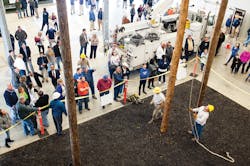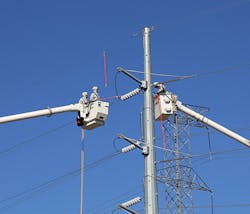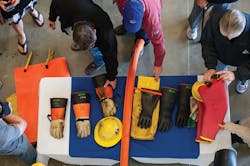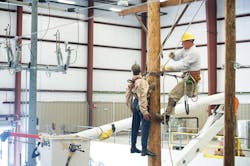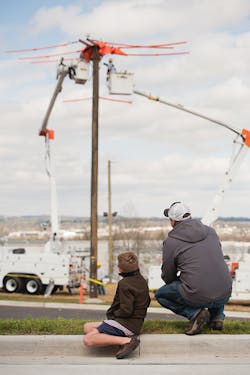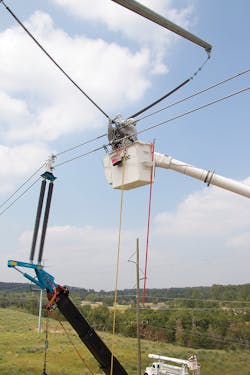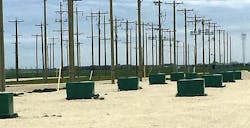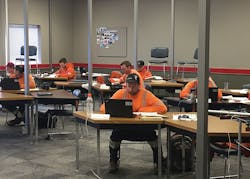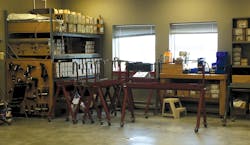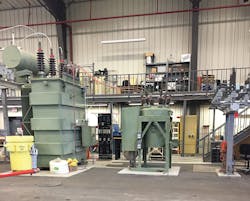As the skilled labor shortage looms, electric utilities nationwide are taking action. Rather than waiting for waves of qualified journeymen linemen to walk out the door, they are building new training centers, investing in apprenticeship programs and focusing on hands-on education.
“Like many utilities and contractors, we are seeing not only a labor shortage but a skilled labor shortage,” said Greggory Bell, vice president of energized services for Quanta Energized Services. “We are not looking to hire just anyone. We want our people to be safe, educated and productive, which is why our new training center — the Lazy Q — was born.”
Bell came out of retirement from a utility on the West Coast to work with Quanta. The Lazy Q training center is on a former cattle ranch near La Grange, Texas. The transmission lines at the facility can be energized fully at high voltage to give journeymen linemen practical, hands-on experience barehanding, hot sticking and working with robotic arms.
“Lots of utilities have training centers with lattice towers and wood poles, but our facility has lines that run a mile and a quarter long, and they’re all energized,” Bell said. “It’s absolutely essential to focus on energized hands-on training with our linemen in the bucket or on the line or ladder. It’s getting harder and harder for utilities to take a line out of service, and we want to provide them with a safe, energized way to get their work done without causing outages to a customer.”
Like Quanta, utilities nationwide are training their field workforce to handle the electrical demands of the future. For example, as utilities integrate renewable energy sources, storage systems, smart grid and demand management, the field workforce must be adaptable, flexible and have new skills and different expertise than the current workforce, according to the U.S. Department of Energy (DOE).
Utilities are rising to the challenge with a hands-on approach to education and training. For example, Manitoba Hydro’s training grounds include a functioning scaled-down version of a substation; 12 pole lines and an underground pad-mount equipment area, which both can be energized at system voltage; a manhole for confined space training; and a fully functioning streetlighting system.
“Being able to perform so many hands-on tasks in a completely controlled environment, and in either a dead and grounded or an energized state, gives our apprentices great knowledge, experience and confidence before heading out into the field,” said Todd Chornoby, trades training manager in the employee learning and development department at Manitoba Hydro.
“Things like technique and body positioning can only be learned from actually performing the tasks, not from reading or watching someone else,” Chornoby explained. “It also gives them the necessary experience of performing tasks while adhering to their Limits of Approach before they are in a field setting.”
Building a New Training Center
To ensure they have a skilled workforce to handle the electricity demands of today and tomorrow, utilities from coast to coast are constructing new training centers. In January 2016, Nashville Electric Service (NES) opened a new training center and T&D service center in the northern part of its system on the opposite side of the river from all its other facilities.
“If there was ever another flooding event such as Nashville experienced in 2010 and access across the river was affected, we would be prepared for it,” said Frank Travis, NES vice president of operations. “Having a training center in north Nashville allows us to keep our men and equipment closer to the customers on this part of the system.”
NES first began exploring the possibility of building a new training facility eight years ago following several electrical contacts and a fatality. After visiting several centers throughout the country, NES selected the best ideas and integrated them into its new training center, which opened in January 2016.
“We have had numerous other utility companies come to NES to take a look,” Travis said. “All have come away impressed with the hopes of opening such a facility at their utility.”
Like other utility training centers, the NES facility includes classrooms for indoor instruction. Two classrooms, which are set up with audiovisual equipment and wired for internet and network access, can serve 24 students each.
Beyond the classrooms, the facility is devoted to hands-on training. NES can deploy any new type of equipment — from overhead line equipment to substation relays — and train its employees on the operation of that equipment in a controlled environment. For example, NES can conduct its annual training for pole-top and bucket rescue from full-height poles in the overhead pole area. The utility also can conduct CPR, automated external defibrillator (AED) and first-aid training when crews have their pole-top and bucket rescue training.
“This facility has a variety of pad-mounted distribution equipment installed inside, and it will allow us to train on bad weather days,” Travis said. “The facility gives us a location to construct new framing or try new equipment first, and to train our personnel in its operation in more ideal conditions.”
The apprentices and journeymen linemen train with a 100-ft by 150-ft training building with 50-ft high ceilings, which enable linemen to use regular 55-ft bucket trucks.
“We can fit up to three trucks in the building to simulate multiple trucks working back to back,” Travis noted.
The pole yard, which takes up about a quarter of the area, includes two rows of five poles spaced about 15 ft apart. In its real-world simulation lab, NES set 40-ft class 4 wood penta-treated poles in giant Christmas tree stands. Once the poles have been chewed up from climbing, the linemen set the poles in place with a digger derrick.
NES constructed an elevated catwalk along the pole yard so instructors can coach the students without raising their voices. While the utility patterned its training center after one in Somerset, Kentucky, the catwalk is a unique feature of the NES training facility. The utility wanted its instructors to be at the same height as a lineman who has climbed a pole or is working from a bucket. By standing on the catwalk, the instructors are within 15 ft of the nearest line of poles.
“They can talk to an apprentice or lineman working on the pole without craning their neck and looking up and hollering to the men working on the pole,” Travis said. “It works really well and gives the instructors a tremendous vantage point.”
On the far end of the pole yard, NES built an underground area, which includes a full-sized network vault and manhole, primary and secondary pull boxes, and a three-phase pad-mounted switch. In addition, the students can train on a three-phase pad-mounted transformer, single-phase pad-mounted transformer and a dead-front, three-phase terminating cabinet. NES also constructed a single-bay substation structure with circuit breakers, regulators, a full-sized transformer and a small substation control building.
Within the simulation lab for confined space training, NES included full-sized transformer vaults and manholes connected by a network of underground conduits. The vaults are then connected to riser poles and pad-mounted transformers.
The vault measures 8 ft wide by 12 ft long by 14 ft deep with a network transformer, high-side switch and low-side protector in it. From a safety standpoint, the utility uses the vault and manholes to conduct confined space training for its electricians. NES conducts this training annually for those who must enter such locations.
“Most equipment that is installed in the field exists inside the training center,” Travis said. “The facility allows us to conduct the training rain or shine, hot or cold, while simulating a variety of emergency situations.”
Working Live
In today’s world, it has become more and more challenging for utilities to have planned outages. In turn, many utilities and their contractors are learning how to work on energized systems. For example, after training its linemen on utility properties, Quanta recently built its own training center. The Lazy Q, a 2200-acre property halfway between Austin and Houston, Texas, began as a way for the utility contractor to train its field workforce on energized lines.
“We needed a training facility that we could control ourselves in the way we wanted to operate it,” Bell explained. “The Lazy Q allowed us to standardize our training for advanced line work for all of our electric operating units.”
Quanta delivered its first barehand training session at the Lazy Q in August 2015, and in the first five months of 2017, about 100 journeymen linemen had been trained and about 80 recertifications had been conducted at the ranch.
Quanta devoted approximately 300 acres of the total 2200 acres at the ranch to training. While the buildings are all powered by the local utility, Quanta designed and operates the electrical system for the advanced training side for T&D.
A generator powers the high-voltage system through a series of step-up transformers and reclosers. Because Quanta controls the system, it can train its linemen for as long as necessary on 69 kV or 345 kV, even on rainy days.
“Linemen can’t work high voltage in the rain, but one day, we had a brief shower that only lasted a half an hour,” Bell recalled. “We conducted training within one of our five large classrooms and, when the rain passed, we dried out our trucks and went back to work. If we were training on a utility property, we would have been done for the day and lost valuable time for our men.”
To increase productivity during training, Quanta has the journeymen linemen stay on-site during the two-week program. Prior to coming to the Lazy Q, Bell conducts an interview with the students so they know what to expect before they set foot on the ranch.
“We want to know their level of expertise, and we give them a set of rules on what they can and can’t do,” Bell explained. “We also tell them what projects they will be doing when they’re here, what equipment they will be using and the requirements regarding homework every night.”
Because the ranch has lodging and a dining hall on-site, the students and instructors can get to know each other personally, leading to a closer working relationship. Each of the journeymen linemen is assigned to a crew and takes turns serving as the foreman several times. As part of this leadership role, the foreman must learn how to write proper work procedures.
“We don’t care in the least whether you are the most experienced on the crew; you will be a crew foreman and you will have to write work procedures, give it to the linemen in verbal form and make them understand it,” Bell said. “It’s all about leading safe.”
To ensure the linemen learn as much as possible during their time at the Lazy Q, Bell tries to partner veteran and less-experienced linemen on the same crew.
“You can’t let two strong linemen go together,” Bell said. “You have to mix and match skill levels, and give the linemen the opportunity to work with someone who they may not know.”
At the Lazy Q, the journeymen linemen have the opportunity to complete a dozen different projects, ranging from a dead-end insulator changeout to a jumper changeout on 69 kV and 345 kV.
“We have a whole array of projects we have designed to test their skills,” Bell said. “Because we can control the system, we can also add in new projects that the linemen might see when they get back to their operating centers and with their customers.”
On the first day of the training session, the journeymen linemen focus on climbing wood poles and lattice structures. At the Lazy Q, the linemen can train on every type of structure available — single concrete or steel monopoles, wood poles and transmission lattice towers — along with single-conductor and two-, three- and four-bundle wire configurations in vertical and horizontal construction.
The Lazy Q is equipped with two barehand-certified double elevators, two hot-stick trailers, two tool trailers, a crane, five robotic arms, and wet- and dry-insulator wash machines. Instructors teach the linemen how to perform a variety of energized work procedures safely using barehand to hot-sticking work methods.
“What we have found throughout the United States is that hot-sticking training has declined since the advent of rubber gloving,” Bell said. “In addition to the advanced lineman training, we also offer this kind of basic training here at the Lazy Q.”
Because Quanta offers a 1-to-4 instructor-to-student ratio, the journeymen linemen can gain a lot of hands-on experience during their two weeks of training. In addition to training outdoors, the linemen also work on laptops and simulators in the classrooms on the Wi-Fi-enabled campus and training grounds.
Providing Hands-on Opportunities
While some utilities have cut the ribbon on their new training centers, Manitoba Hydro built its trades training center nearly 20 years ago. Spanning more than 33,368 sq ft, the center includes classrooms, workshops and a high bay area, which is where the indoor training takes place.
“Basically, any tasks that can be performed outside, we can also complete indoors, if necessary,” Chornoby says. “In our trade, we try our best not to let weather push us indoors, as working in the elements is a large part of everyday life in this trade.”
Within the shops, apprentices can practice more specialized work such as splicing and terminating many different types and sizes of underground primary and secondary cables.
Manitoba Hydro recently created and started to deliver an underground network technician specialist training program for journeymen power line technicians who choose that avenue. To set up a realistic area for confined space training, Manitoba Hydro included a manhole with high-voltage cables that can be energized at 12 kV. In addition, an underground network transformer feeds into the manhole, which gives technicians the opportunity to train and practice secondary network connections.
Also, the newer underground area has double runs of cable between each piece of equipment, which enables the trainers to simulate faults anywhere in the system. Manitoba Hydro’s tower line includes nine different transmission tower structures that can be used for all aspects of transmission training.
In addition to the indoor training facilities, Manitoba Hydro’s apprentices also can train within an 8-acre outdoor training yard. For example, within the overhead portion of the training yard, the field workforce can train on three pole lines that are energized at 15 kV, two poles energized at 25 kV, and one permanently dead and grounded pole line. In addition, two separate underground training areas, which are energized at 15 kV, can be used for both switching procedures and underground troubleshooting.
“Having this kind of plant at our disposal is crucial to the success of our training program and the development of our apprentices,” Chornoby said. “Virtually every task they train on will include a practice run with the line de-energized. During that time, the instructor will take the opportunity to offer as much instruction and feedback as possible. This is a very valuable training tool.”
After completing the practice run, the instructor gives feedback, answers questions and gives the apprentices permission to challenge their field competency check. After successful completion of the task, the instructor again provides feedback. If the trainee is still unsuccessful at the task, the instructor discusses all errors or safety concerns, answers questions and has the trainee redo the tasks with a different instructor.
“This moves from a training aspect toward more of an evaluation of their abilities and knowledge,” Chornoby said. “At the absolute forefront of every field competency check is safety. Having the students perform these tasks gives them the opportunity to train and practice every step of a job.”
Infusing Technology in the Classroom
Training centers not only give apprentices and line workers practical, hands-on experience before they work in the field, but they also include modern classrooms. Manitoba Hydro recently renovated its classrooms with electrical and communications drops, so each student can access all training materials through the intranet or web.
On the Manitoba Hydro intranet, the curriculum for the power line technician training program is available to all employees and can be accessed from anywhere in the province. While the curriculum for this program — as well as many other training tools such as instructional videos — is available on the intranet, no testing material is available online.
“We feel the best way to maintain the consistency and credibility of our evaluation process is to keep all evaluation material in-house,” Chornoby noted.
In addition, the classrooms are equipped with SMART Boards electronic whiteboards and ClickShare projectors, and one room features videoconferencing capabilities.
“The days of the binders full of hard-copy learning modules are all behind us, as all the learning is done electronically,” Chornoby said. “We have access to online simulators to practice such tasks as connecting transformers or performing overhead and underground switching, and troubleshooting.”
Chornoby says the biggest difference in training today is the delivery format. Today, the entire curriculum is now computer based and delivered in a Training Procedures for Safe Work (TPSWs) format. Currently, a transition team is converting Manitoba Hydro’s old training modules from written format to an electronic format and also integrating its safe work procedures into the TPSWs.
As TPSWs are finalized, the old safe work procedures are eliminated, which results in one less set of documents to reference and maintain, Chornoby says.
“One major advantage of the TPSWs is they are available on every laptop,” Chornoby said. “The content of the entire training program is updated every morning, providing all field staff with access to the most recent version of all material. This has been an overdue upgrade to our training materials and delivery, and a comfortable transition for this younger generation.”
Training on New Tools
As the industry continues to evolve and change, electric utilities are ensuring training facilities are equipping their field workforce with new skills. For example, Manitoba Hydro added pole lines to its pole yard to accommodate the rise in hiring numbers and the diversity of tasks performed. In addition, the utility has added a second underground switching field to facilitate more troubleshooting options and has installed additional wood-pole 66-kV structures.
At Manitoba Hydro, the trades training department works closely with the standards and engineering department to test and install new equipment, such as Viper automated circuit reclosers. The utility also has added an area for vehicle equipment training, from digger trucks to all-terrain vehicles and utility vehicles. In the past year, the utility added a line of towering poplar trees directly underneath one of its pole lines. This portion of the line is devoted to training junior staff on basic maintenance and tree trimming, while the remainder of the line is for instructing line workers how to respond to storms and outages.
In addition, Manitoba Hydro has focused on fall protection. After much testing, trials and feedback, the utility is in the midst of a complete changeover to the Buckingham SuperSqueeze climbing belt. As such, the trades training department has been instrumental in the testing process as well as facilitating the changeout procedures.
At Quanta’s Lazy Q ranch training facility, linemen can learn how to handle and operate robotic arms on T&D voltages up to 345 kV. By learning how to use a robotic arm for one phase or three phases, they can work toward robotic arm certification. Because operating the robotic arm requires a significant amount of weight and force calculations, the students must spend a day and a half learning the related mathematical skills in the classroom.
Soon Quanta also plans to energize its own underground system for training its advanced linemen.
“The key to this is the safe operation of our system and the safety of our linemen,” Bell said. “That is the rock bottom line.” ♦
Sidebar: 10 Tips for Recruiting and Training the Next Generation of Line Workers
Like other utilities across North America, Manitoba Hydro is continuously looking for skilled line workers to join its ranks. The utility’s graduating numbers vary from year to year as its hiring numbers fluctuate. While its applicant numbers are lower than in previous years, the utility has been able to maintain about a 90% success rate in its training program and still be recognized as a top 100 employer in its province.
“We have a great deal of potential for bright futures for workers and are still fortunate enough to fill each hire group with quality apprentices,” said Todd Chornoby, trades training manager in the employee learning and development department at Manitoba Hydro.
Here are some strategies the utility uses to bring new apprentices on board and to train its power line technicians for the future.
1. Continually search for new workers. Manitoba Hydro recruits through career fairs, career expos in high schools, hands-on events in indigenous communities, and trade videos and information on its website.
2. Hire quality instructors. The strength of Manitoba Hydro’s training program is dependent on the dedication, pride and professionalism of the instructors, says Chornoby. And he says the front-office staff is an integral part of the center’s success, because they enable instructors to concentrate their time on teaching the trade.
“We have a world-class training facility and program that is recognized throughout North America. This can be credited to our team and our passion to be the best training program possible,” Chornoby says.
3. Create a preplacement program. As an equal opportunity employer, Manitoba Hydro has a line trades preplacement program for indigenous candidates who do not meet the minimum academic qualifications for the power line technician program. The preplacement program provides individuals with paid academic upgrading as well as on-the-job training and experience. In addition, if candidates are unsuccessful in the line trades program, they may be better suited for other work within the corporation, Chornoby notes.
“For a training program to maintain credibility, there needs to be the opportunity to be unsuccessful,” he said.
4. Test out the job candidates. The hiring process consists of a two-day skills assessment and trade orientation, which includes both written and hands-on trade-related tasks. This two-day event gives Manitoba Hydro the opportunity to assess the candidates’ skills and gives the candidates the opportunity to see if this trade is for them.
“Thirty feet up a pole is quite different than 30 ft up a scaffold or man lift,” Chornoby said. “Candidates are evaluated on their physical skills and ability to perform work such as cable prep work, pole climbing and various other skills. A large emphasis is put on the attitude and character displayed by candidates. A potential new hire must demonstrate they can be a part of a team, follow directions and pay attention to detail.”
5. Teach core skills of the trade. During their training, Manitoba Hydro’s apprentices learn basic electrical theory, safety rules and procedures, job planning, knowledge of overhead and underground electrical systems, climbing, hand skills, teamwork and character.
6. Emphasize safety. Trainees must learn how to conduct an in-depth tailboard discussion, identifying all hazards and how they will be addressed. They use and apply all safety rules, procedures and equipment, and perform the task as they would in the field.
“Every trainee leaves here knowing one good way he or she can approach this task in the field,” Chornoby said.
7. Establish a code of conduct. While at Manitoba Hydro’s Stonewall training center, students and instructors are expected to follow a code of conduct by arriving early with shirts tucked in and boots tied up. They also must use quiet and respectful language throughout the training facility and behave professionally. At the end of the day, the students clean the shops and place their chairs on top of their desks to help the evening cleaning staff.
“We promote pride in our trade and in ourselves, and it is expected to carry over to the field,” Chornoby explained.
8. Provide in-depth training. Once apprentices reach the hours required to move on to the next level of their apprenticeship, they read the electronic Training Procedures for Safe Work, challenge a written competency check, practice a field task and then perform a field evaluation check. They learn many new skills and are exposed to new tools and work procedures at each level.
9. Send apprentices back to the field. During the on-the-job training, managers and field staff must support the training program, only permit apprentices to work on what they are trained to do and provide the proper supervision for the task at hand. As the apprentices move along in the trade and prove themselves, they will be given more responsibilities, greater supervisory roles and the opportunity to plan and carry out more complex jobs.
10. Rotate apprentices to different work locations or crews. Manitoba Hydro gives its apprentices diverse exposure to all aspects of power line work every four to eight months. By filling out exposure sheets identifying the experience they have gained and what future training they require, the apprentices can help to identify any gaps in their training to date. In turn, the training coordinator can select the department and location that can best give the apprentice the work experience required to make him or her a well-rounded tradesperson.
“Throughout a trainee’s apprenticeship, they will work in many different locations, on different crews, and gain experience using a variety of tools and equipment along with diverse methods of executing any given job plan,” Chornoby said.
Read the complete Linemen supplement in the September 2017 issue.
About the Author
Amy Fischbach
Electric Utilities Operations
Amy Fischbach is the Field Editor for T&D World magazine and manages the Electric Utility Operations section. She is the host of the Line Life Podcast, which celebrates the grit, courage and inspirational teamwork of the line trade. She also works on the annual Lineworker Supplement and the Vegetation Management Supplement as well as the Lineman Life and Lineman's Rodeo News enewsletters. Amy also covers events such as the Trees & Utilities conference and the International Lineman's Rodeo. She is the past president of the ASBPE Educational Foundation and ASBPE and earned her bachelor's and master's degrees in journalism from Kansas State University. She can be reached at [email protected].
